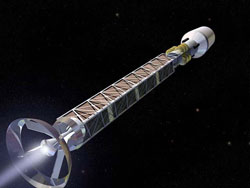The Most Antimatter

Antimatter has fueled the imaginations of science fiction enthusiasts for decades, but in reality only miniscule quantities of it have been isolated. In the 21 January PRL, Japanese researchers describe isolating more antimatter than ever before. Their technique trapped 50 times as many antiprotons from high energy collisions as previous methods could. Although the increased numbers won’t be powering spaceships anytime soon, they could make possible new precision measurements of basic laws of physics.
Antiprotons, which have the opposite charge and other properties from ordinary protons, are produced by the trillions in high-energy particle collisions at laboratories like CERN in Geneva. The antiprotons emerge from these collisions with energies of billions of electron volts. But precision measurements require particles as cold as a few degrees above absolute zero, which corresponds to less than a thousandth of an electron volt of energy per particle. The antiproton decelerator at CERN slows the “hot” antiprotons to a relatively cool five million electron volts, collecting them in 90-nanosecond-long bunches of about 30 million antiprotons. Researchers further cool the particles by passing them through a thick, cold foil, from which fewer than one out of 1,000 emerge slow enough to trap and cool to much lower temperatures. Still, that’s enough antiprotons for some experiments, such as precise measurements of their charge-to-mass ratio.
But researchers need many more antiprotons for some tests of fundamental asymmetries in the laws of physics–such as searches for tiny differences between hydrogen and antihydrogen. To increase the numbers, Japanese and Hungarian researchers led by Yasunori Yamazaki of the Japanese government institution RIKEN and the University of Tokyo sent the output of the antiproton decelerator into a radio-frequency quadrupole decelerator. This four-meter-long device is essentially a traditional particle accelerator run backwards. It slows particles with a series of electric fields that pass bunches of them from one spot to the next, like a “bucket brigade” that slows down as the buckets approach the end. At the output, the team rounded up about 1.2 million antiprotons from each bunch at between 10 thousand and 120 thousand electron volts in a simple ion trap. The trapped particles continued to cool, which the researchers showed by monitoring the oscillations of electrons trapped along with them.
Yamazaki says these antiprotons could be used to create a large number of antihydrogen atoms if they were combined with positrons (anti-electrons). Previous antihydrogen experiments had to make do with 50 times fewer antiprotons trapped from each bunch out of the decelerator. In another class of experiments made possible by larger numbers, an antiproton could be captured in place of an electron by a positive nucleus. The death spiral of the antiproton into the nucleus would yield unique information about the structure of the nucleus, Yamazaki says.
Gerald Gabrielse of Harvard University says that more antiprotons would be very useful, although researchers will have to get used to the costs of such large decelerators that replace a simple foil. Still, Gabrielse says, the work is “a very important exploration of one alternative,” for producing larger numbers of antiprotons.
–Don Monroe
Don Monroe is a freelance science writer in Murray Hill, New Jersey.
More Information
C. H. Storry et al., “First Laser-Controlled Antihydrogen Production,” Phys. Rev. Lett. 93, 263401 (2004) from the 31 December PRL announced laser controlled production of antihydrogen
Physics News Update story from December 2004 explains the above paper
Physics News Update story from August 2004 on antihydrogen measurements
first and second experiments to create cold antihydrogen, as described in Physics News Update in 2002


